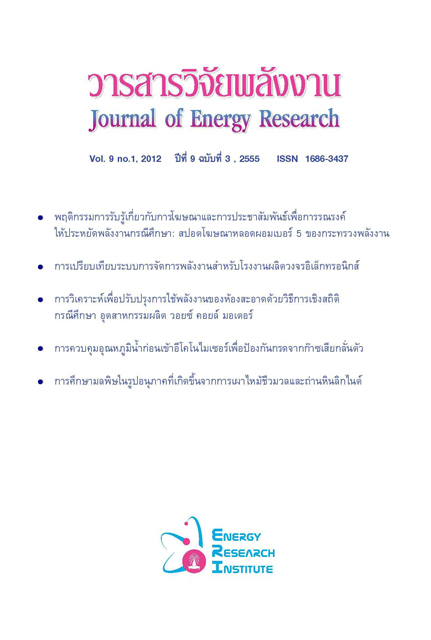การวิเคราะห์เพื่อปรับปรุงการใช้พลังงานของห้องสะอาดด้วยวิธีการเชิงสถิติ กรณีศึกษา อุตสาหกรรมผลิต วอยซ์ คอยล์ มอเตอร์
Main Article Content
Abstract
ห้องสะอาดคือห้องที่ถูกควบคุมสภาวะแวดล้อมภายใน เป็นพื้นที่ที่ต้องควบคุมอุณหภูมิ ความชื้นสัมพัทธ์ ความเร็วลม ความดันอากาศ และ อนุภาคแขวนลอยในอากาศ โดยเงื่อนไขข้างต้นนี้ในแต่ละ อุตสาหกรรมการผลิตสินค้า จะต้องเป็นไปตามข้อกำหนดของลูกค้าเป็นหลัก จากการควบคุมสภาวะความชื้นสัมพัทธ์ให้เป็นไปตามเงื่อนไขทำให้ระบบปรับอากาศต้องทำงานตลอดเวลา ผลการบันทึกการใช้พลังงานไฟฟ้าของอุตสาหกรรมผลิต วอยซ์ คอยล์ มอเตอร์ ในปี 2552 และ 2553 สัดส่วนการใช้พลังงานไฟฟ้าในระบบปรับอากาศของห้องสะอาดนั้นเพิ่มมากขึ้นจาก 40.35% เป็น 41.68% คิดเทียบจากปริมาณของการใช้พลังงานทั้งหมดของโรงงาน จากสถิติ และการจดบันทึกข้อมูลพฤติกรรมที่ผิดปกติในกระบวนการผลิต ได้ถูกนำมาวิเคราะห์เพื่อแสดงความสัมพัทธ์กันระหว่าง อุณหภูมิและความชื้นสัมพัทธ์ โดยใช้แบบจำลองสมการการถดถอยเชิงเส้นอย่างง่ายและสมการต้นแบบการถดถอยพหุคูณ ด้วยการตั้งสมมติฐานให้อุณหภูมิควบคุมของห้องสะอาดทุกคลาสเพิ่มขึ้น 1 องศาเซลเซียส และให้ความชื้นสัมพัทธ์ของห้องสะอาดทุกคลาสเพิ่มขึ้น 1% แล้วแทนค่าอุณหภูมิและความชื้นสัมพัทธ์ลงในสมการต้นแบบเพื่อจำลองพยากรณ์ค่าไฟฟ้าที่อาจจะประหยัดได้ ผลจากการจำลองด้วยสมการต้นแบบคือ ภายใน 24 เดือนอาจจะประหยัดค่าไฟฟ้าได้ เท่ากับ 5,9695,556 บาท หากปรับอุณหภูมิขึ้น 1 องศาเซลเซียส และปรับความชื้นสัมพัทธ์ขึ้น 1%
ENERGY ANALYSIS FOR IMPROVEMENT OF CLEANROOM VIA STATISTICAL METHOD : A CASE STUDY OF VOICE COIL MOTOR MANUFACTURING INDUSTRY
Kasinee Promthi
Energy Technology and Management Program, Graduate School, Chulalongkorn University, Pathumwan, Bangkok
Cleanroom is a controlled environment, where temperature, relative humidity, air velocity, air pressure and suspended particle are regulated for manufacturing products according to customer's requirements. Because of steady humidity requirement, air conditioning systems have to be run at all time. According to the records of electricity consumption of voice coil motor industry, its consumption rate of year 2009 and 2010 for air conditioning systems in all cleanrooms had increased from 40.35% to 41.68% with respect to the total amount of the electricity consumption of the whole factory. Statistics and recorded abnormalities of all production activities were brought into analyses for determining correlations between temperature and relative humidity base on a simple linear regression model and Multiple regression model. Then the determined model with an assumption that temperature set point in each clean room was increased for 1 degree Celsius, and humidity set point in each clean room was increased for 1% was employed to simulate a plausible decrease in cost of electricity. It was found that the cost of electricity would be saved about 5,9695,556 baht within 24 months if increase temperature set point in each clean room for 1 degree Celsius, and also increase humidity set point in each clean room for 1%

